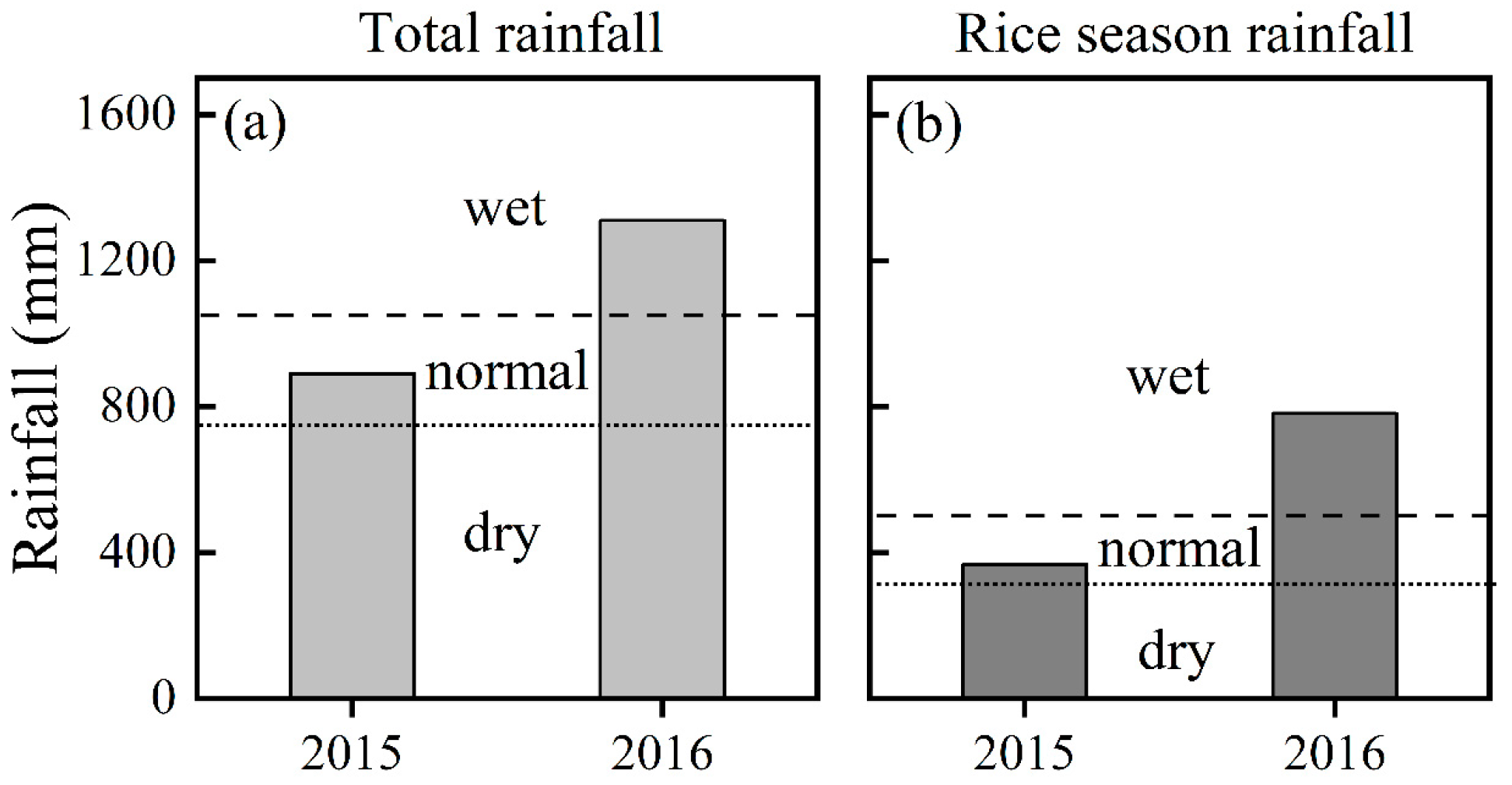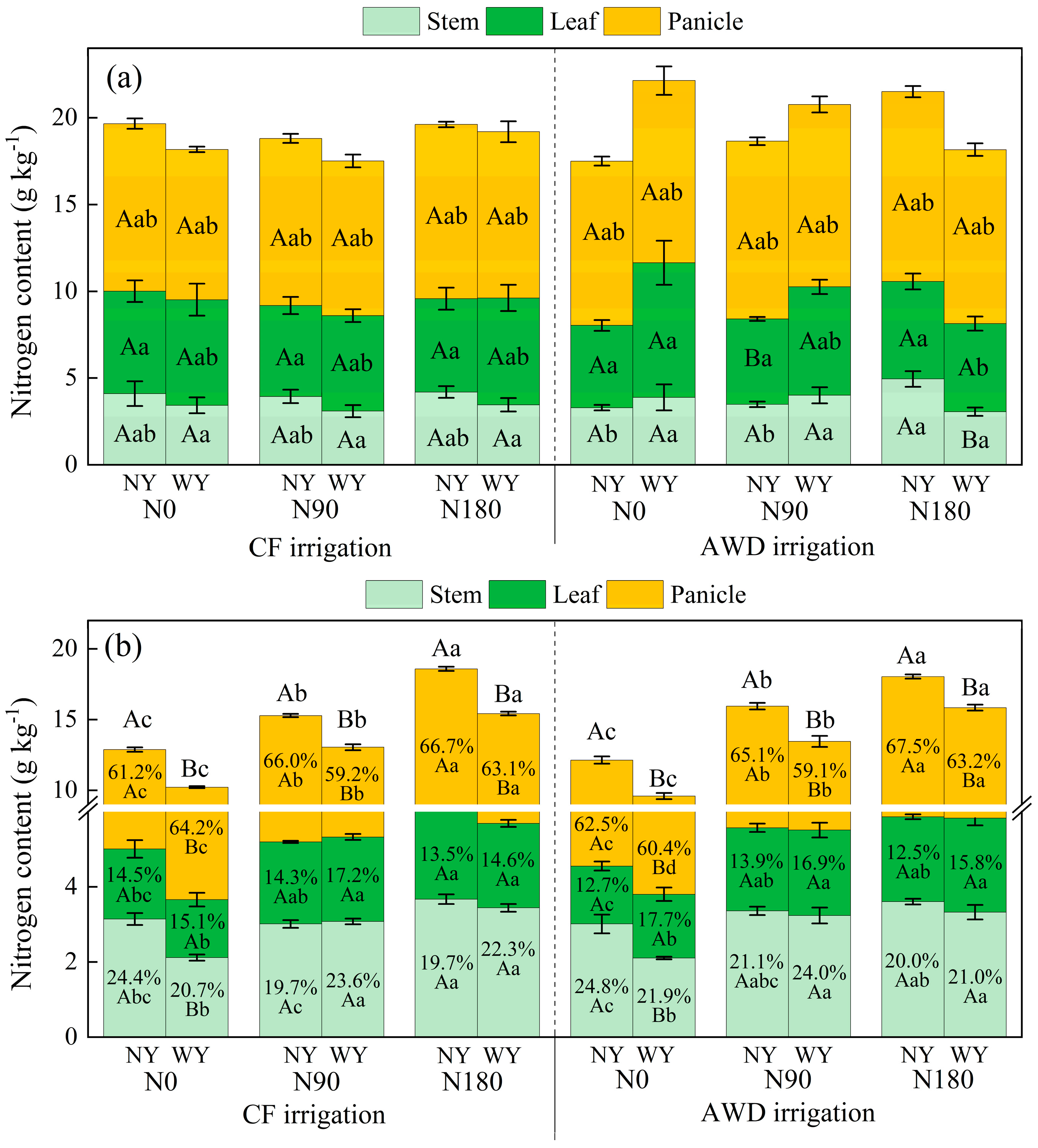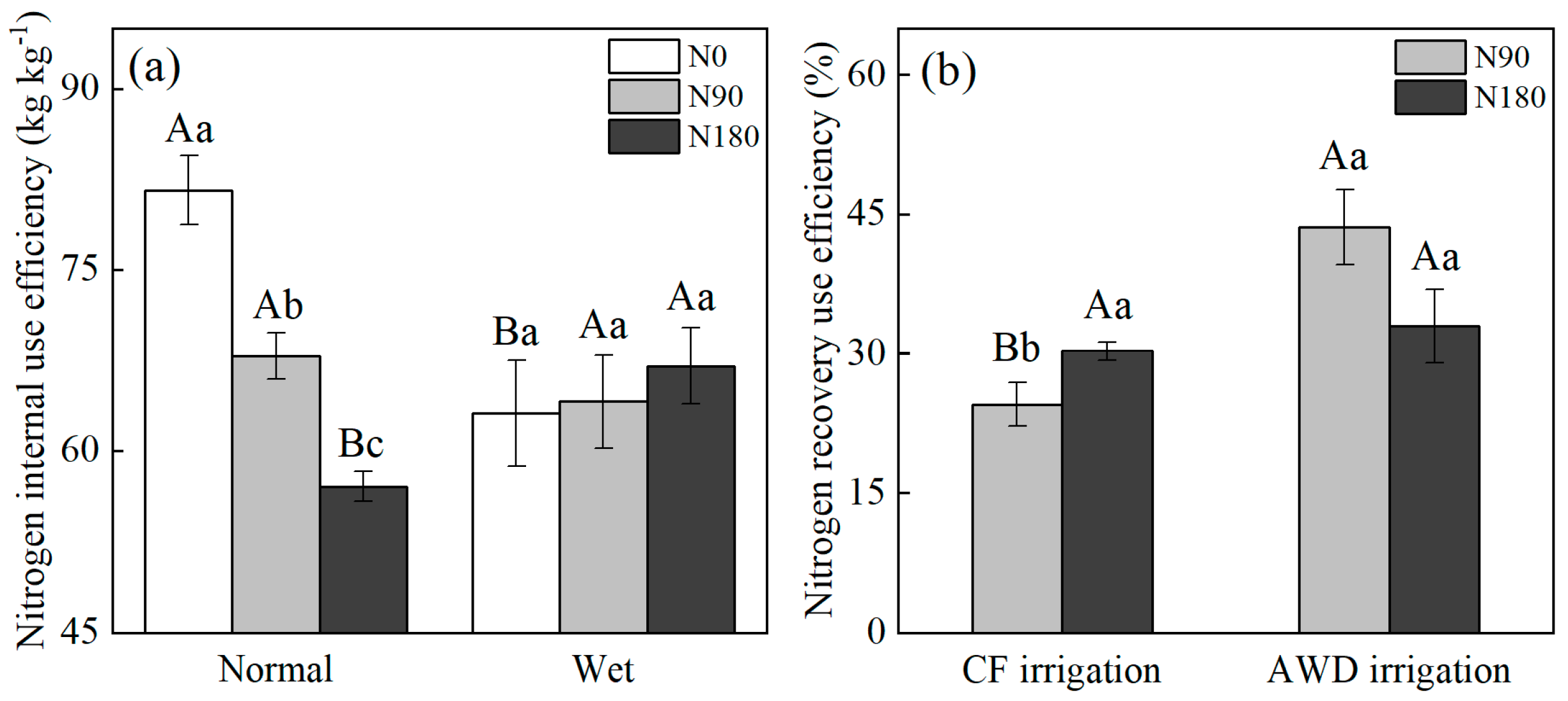Increasing Nitrogen Fertilizer Application Is a Feasible Strategy to Mitigate Rice Yield Reduction in Wet Year
Abstract
1. Introduction
2. Materials and Methods
2.1. Experimental Site and Experimental Field
2.2. Experimental Design and Field Management
2.3. Sampling and Analysis
2.4. Calculations and Data Analysis
2.4.1. Hydrological Years
2.4.2. Nitrogen Uptake and NUE
2.4.3. Statistical Analysis
3. Results
3.1. Meteorological Conditions and Rainfall Patterns
3.2. Rice Yield and Growth
3.3. Nitrogen Uptake and Components
3.4. Nitrogen Use Efficiency (NUE)
3.5. Correlation Analysis for Rice Yield and Nitrogen Uptake
4. Discussion
5. Conclusions
Supplementary Materials
Author Contributions
Funding
Data Availability Statement
Conflicts of Interest
References
- Liu, Y.; Ma, C.; Li, G.; Jiang, Y.; Hou, P.; Xue, L.; Yang, L.; Ding, Y. Lower dose of controlled/slow release fertilizer with higher rice yield and N utilization in paddies: Evidence from a meta-analysis. Field Crops Res. 2023, 294, 108879. [Google Scholar] [CrossRef]
- Zhang, Y.; Wang, Y.; Niu, H. Spatio-temporal variations in the areas suitable for the cultivation of rice and maize in China under future climate scenarios. Sci. Total Environ. 2017, 601, 518–531. [Google Scholar] [CrossRef] [PubMed]
- Liao, B.; Wu, X.; Yu, Y.; Luo, S.; Hu, R.; Lu, G. Effects of mild alternate wetting and drying irrigation and mid-season drainage on CH4 and N2O emissions in rice cultivation. Sci. Total Environ. 2020, 698, 134212. [Google Scholar] [CrossRef]
- Zhang, Z.; Li, Y.; Chen, X.; Wang, Y.; Niu, B.; Liu, D.; He, J.; Pulatov, B.; Hassan, I.; Meng, Q. Impact of climate change and planting date shifts on growth and yields of double cropping rice in southeastern China in future. Agric. Syst. 2023, 205, 103581. [Google Scholar] [CrossRef]
- Westra, S.; Fowler, H.; Evans, J.; Alexander, L.; Berg, P.; Johnson, F.; Kendon, E.; Lenderink, G.; Roberts, N. Future changes to the intensity and frequency of short-duration extreme rainfall. Rev. Geophys. 2014, 52, 522–555. [Google Scholar] [CrossRef]
- Subash, N.; Singh, S.; Priya, N. Extreme rainfall indices and its impact on rice productivity—A case study over sub-humid climatic environment. Agric. Water Manag. 2011, 98, 1373–1387. [Google Scholar] [CrossRef]
- Boonwichai, S.; Shrestha, S.; Babel, M.; Weesakul, S.; Datta, A. Climate change impacts on irrigation water requirement, crop water productivity and rice yield in the Songkhram River Basin, Thailand. J. Clean. Prod. 2018, 198, 1157–1164. [Google Scholar] [CrossRef]
- Chen, X.; Wang, L.; Niu, Z.; Zhang, M.; Li, J. The effects of projected climate change and extreme climate on maize and rice in the Yangtze River Basin, China. Agric. For. Meteorol. 2020, 282, 107867. [Google Scholar] [CrossRef]
- Schneider, P.; Asch, F. Rice production and food security in Asian Mega deltas—A review on characteristics, vulnerabilities and agricultural adaptation options to cope with climate change. J. Agron. Crop Sci. 2020, 206, 491–503. [Google Scholar] [CrossRef]
- Auffhammer, M.; Ramanathan, V.; Vincent, J. Climate change, the monsoon, and rice yield in India. Clim. Chang. 2012, 111, 411–424. [Google Scholar] [CrossRef]
- Rahman, M.A.; Kang, S.; Nagabhatla, N.; Macnee, R. Impacts of temperature and rainfall variation on rice productivity in major ecosystems of Bangladesh. Agric. Food Secur. 2017, 6, 1–11. [Google Scholar] [CrossRef]
- Abbas, S.; Mayo, Z. Impact of temperature and rainfall on rice production in Punjab, Pakistan. Environ. Dev. Sustain. 2021, 23, 1706–1728. [Google Scholar] [CrossRef]
- Gu, J.; Yang, J. Nitrogen (N) transformation in paddy rice field: Its effect on N uptake and relation to improved N management. Crop Environ. 2022, 1, 7–14. [Google Scholar] [CrossRef]
- Li, J.; Wan, Y.; Wang, B.; Waqas, M.; Cai, W.; Guo, C.; Zhou, S.; Su, R.; Qin, X.; Gao, Q.; et al. Combination of modified nitrogen fertilizers and water saving irrigation can reduce greenhouse gas emissions and increase rice yield. Geoderma 2018, 315, 1–10. [Google Scholar] [CrossRef]
- Jiao, J.; Shi, K.; Li, P.; Sun, Z.; Chang, D.; Shen, X.; We, D.; Song, X.; Liu, M.; Li, H.; et al. Assessing of an irrigation and fertilization practice for improving rice production in the Taihu Lake region (China). Agric. Water Manag. 2018, 201, 91–98. [Google Scholar] [CrossRef]
- Carrijo, D.; Lundy, M.; Linquist, B. Rice yields and water use under alternate wetting and drying irrigation: A meta-analysis. Field Crops Res. 2017, 203, 173–180. [Google Scholar]
- Qi, D.; Zhu, J.; Wang, X. Nitrogen loss via runoff and leaching from paddy fields with the proportion of controlled-release urea and conventional urea rates under alternate wetting and drying irrigation. Environ. Sci. Pollut. Res. 2023, 30, 61741–61752. [Google Scholar] [CrossRef] [PubMed]
- Thakur, A.; Rath, S.; Patil, D.; Kumar, A. Effects on rice plant morphology and physiology of water and associated management practices of the system of rice intensification and their implications for crop performance. Paddy Water Environ. 2011, 9, 13–24. [Google Scholar] [CrossRef]
- Ishfaq, M.; Farooq, M.; Zulfiqar, U.; Hussain, S.; Akbar, N.; Nawaz, A.; Anjum, S. Alternate wetting and drying: A water-saving and ecofriendly rice production system. Agric. Water Manag. 2020, 241, 106363. [Google Scholar] [CrossRef]
- Wang, Z.; Zhang, W.; Beebout, S.S.; Zhang, H.; Liu, L.; Yang, J.; Zhang, J. Grain yield, water and nitrogen use efficiencies of rice as influenced by irrigation regimes and their interaction with nitrogen rates. Field Crops Res. 2016, 193, 54–69. [Google Scholar] [CrossRef]
- Qun, Z.; Rui, Y.; Zhang, W.; Gu, J.; Liu, L.; Zhang, H.; Wang, Z.; Yang, J. Grain yield, nitrogen use efficiency and physiological performance of indica/japonica hybrid rice in response to various nitrogen rates. J. Integr. Agric. 2023, 22, 63–79. [Google Scholar]
- Xu, G.; Lu, D.; Wang, H.; Li, Y. Morphological and physiological traits of rice roots and their relationships to yield and nitrogen utilization as influenced by irrigation regime and nitrogen rate. Agric. Water Manag. 2018, 203, 385–394. [Google Scholar] [CrossRef]
- Zhang, W.; Yu, J.; Xu, Y.; Wang, Z.; Liu, L.; Zhang, H.; Gu, J.; Zhang, J.; Yang, J. Alternate wetting and drying irrigation combined with the proportion of polymer-coated urea and conventional urea rates increases grain yield, water and nitrogen use efficiencies in rice. Field Crops Res. 2021, 268, 108165. [Google Scholar] [CrossRef]
- Pan, G.; Cao, G.; Cai, M.; Wang, J.; Wang, R.; Yuan, B.; Zhai, J. Effects of nitrogen application on nitrogen use efficiency, grain yield and quality of rice under different water regimes. Plant Nutr. Fertil. Sci. 2009, 15, 283–289. [Google Scholar]
- Su, W.; Lu, J.; Wang, W.; Li, X.; Ren, T.; Cong, R. Influence of rice straw mulching on seed yield and nitrogen use efficiency of winter oilseed rape (Brassica napus L.) in intensive rice–oilseed rape cropping system. Field Crops Res. 2014, 159, 53–61. [Google Scholar] [CrossRef]
- Li, F.; Zhang, M.; Zhao, Y.; Jiang, R. Multi-target planting structure adjustment under different hydrologic years using AquaCrop model. Theor. Appl. Climatol. 2020, 142, 1343–1357. [Google Scholar] [CrossRef]
- Geng, M.; Wang, K.; Yang, N.; Qian, Z.; Li, F.; Zou, Y.; Chen, X.; Deng, Z.; Xie, Y. Is water quality better in wet years or dry years in river-connected lakes? A case study from Dongting Lake, China. Environ. Pollut. 2021, 290, 118115. [Google Scholar] [CrossRef]
- Rosenzweig, C.; Elliott, J.; Deryng, D.; Ruane, A.; Müller, C.; Arneth, A.; Boote, K.; Folberth, C.; Glotter, M.; Khabarov, N.; et al. Assessing agricultural risks of climate change in the 21st century in a global gridded crop model intercomparison. Proc. Natl. Acad. Sci. USA 2014, 111, 3268–3273. [Google Scholar] [CrossRef]
- Sui, Y.; Lang, X.; Jiang, D. Projected signals in climate extremes over China associated with a 2 C global warming under two RCP scenarios. Int. J. Climatol. 2018, 38, e678–e697. [Google Scholar] [CrossRef]
- He, L.; Cleverly, J.; Wang, B.; Jin, N.; Mi, C.; Liu, D.L.; Yu, Q. Multi-model ensemble projections of future extreme heat stress on rice across southern China. Theor. Appl. Climatol. 2018, 133, 1107–1118. [Google Scholar] [CrossRef]
- Xu, X.; Liu, J.; Cao, M. Impact of recent climate fluctuation and LUCC process on potential productivity for crops in Northeast China. Sci. Geogr. Sin. 2007, 27, 318. [Google Scholar]
- Wang, T.; Lü, C.; Yu, B. Assessing the potential productivity of winter wheat using WOFOST in the Beijing-Tianjin-Hebei region. J. Nat. Resour. 2010, 25, 475–487. [Google Scholar]
- Chen, X.; Zhu, P.; Zhang, Y.; Li, L. Plum rain enhances porewater greenhouse gas fluxes and weakens the acidification buffering potential in saltmarshes. J. Hydrol. 2023, 616, 128686. [Google Scholar]
- Wang, Y.; Lu, J.; Ren, T.; Hussain, S.; Guo, C.; Wang, S.; Cong, R.; Li, X. Effects of nitrogen and tiller type on grain yield and physiological responses in rice. AoB Plants 2017, 9, plx012. [Google Scholar] [CrossRef] [PubMed]
- Zhen, B.; Guo, X.; Zhou, X.; Lu, H.; Wang, Z. Effect of the alternating stresses of drought and waterlogging on the growth, chlorophyll content, and yield of rice (Oryza sativa L.). J. Irrig. Drain. Eng. 2019, 145, 04019004. [Google Scholar] [CrossRef]
- Pan, J.; Sharif, R.; Xu, X.; Chen, X. Mechanisms of waterlogging tolerance in plants: Research progress and prospects. Front. Plant Sci. 2021, 11, 627331. [Google Scholar] [CrossRef]
- Linquist, B.; Liu, L.; Van Kessel, C.; Van Groenigen, K. Enhanced efficiency nitrogen fertilizers for rice systems: Meta-analysis of yield and nitrogen uptake. Field Crops Res. 2013, 154, 246–254. [Google Scholar] [CrossRef]
- Hou, W.; Xue, X.; Li, X.; Khan, M.R.; Yan, J.; Ren, T.; Cong, R.; Lu, J. Interactive effects of nitrogen and potassium on: Grain yield, nitrogen uptake and nitrogen use efficiency of rice in low potassium fertility soil in China. Field Crops Res. 2019, 236, 14–23. [Google Scholar]
- Ntanos, D.A.; Koutroubas, S. Dry matter and N accumulation and translocation for Indica and Japonica rice under Mediterranean conditions. Field Crops Res. 2002, 74, 93–101. [Google Scholar] [CrossRef]
- Zhang, J.; Liu, J.; Zhang, J.; Zhao, F.; Cheng, Y.; Wang, W. Effects of nitrogen application rates on translocation of dry matter and nitrogen utilization in rice and wheat. Acta Agron. Sin. 2010, 36, 1736–1742. [Google Scholar] [CrossRef]
- Zhang, Y.; Fan, J.; Zhang, Y.; Wang, D.; Wang, Q.; Shen, Q. N accumulation and translocation in four japonica rice cultivars at different N rates. Pedosphere 2007, 17, 792–800. [Google Scholar] [CrossRef]
- Yao, Y.; Zhang, M.; Tian, Y.; Zhao, M.; Zhang, B.; Zeng, K.; Zhao, M.; Yin, B. Urea deep placement in combination with Azolla for reducing nitrogen loss and improving fertilizer nitrogen recovery in rice field. Field Crops Res. 2018, 218, 141–149. [Google Scholar] [CrossRef]
- Ye, Y.; Liang, X.; Chen, Y.; Liu, J.; Gu, J.; Guo, R.; Li, L. Alternate wetting and drying irrigation and controlled-release nitrogen fertilizer in late-season rice. Effects on dry matter accumulation, yield, water and nitrogen use. Field Crops Res. 2013, 144, 212–224. [Google Scholar] [CrossRef]
- Peng, S.; Buresh, R.; Huang, J.; Yang, J.; Zou, Y.; Zhong, X.; Wang, G.; Zhang, F. Strategies for overcoming low agronomic nitrogen use efficiency in irrigated rice systems in China. Field Crops Res. 2006, 96, 37–47. [Google Scholar] [CrossRef]
- Cao, X.; Wu, L.; Lu, R.; Zhu, L.; Zhang, J.; Jin, Q. Irrigation and fertilization management to optimize rice yield, water productivity and nitrogen recovery efficiency. Irrig. Sci. 2021, 39, 235–249. [Google Scholar] [CrossRef]
- Qiao, J.; Yang, L.; Yan, T.; Xue, F.; Zhao, D. Nitrogen fertilizer reduction in rice production for two consecutive years in the Taihu Lake area. Agric. Ecosyst. Environ. 2012, 146, 103–112. [Google Scholar] [CrossRef]








| Rice Yield | Tillering Number | Plant Height | Aboveground Biomass | Harvest Index | |
|---|---|---|---|---|---|
| t ha−1 | m−2 | cm | t ha−1 | % | |
| Year (Y) a | |||||
| Normal | 8.38 a | 189 a | 116.9 a | 15.5 a | 54.9 a |
| Wet | 6.41 b | 165 b | 115.0 a | 12.9 b | 49.5 b |
| Irrigation method (I) b | |||||
| CF | 7.35 a | 177 a | 116.4 a | 14.3 a | 51.6 a |
| AWD | 7.43 a | 177 a | 115.4 a | 14.2 a | 52.8 a |
| Nitrogen regime (N) c | |||||
| N0 | 6.24 c | 140 c | 108.9 c | 11.2 c | 55.1 a |
| N90 | 7.39 b | 175 b | 116.4 b | 14.4 b | 51.0 b |
| N180 | 8.54 a | 216 a | 122.5 a | 17.0 a | 50.5 b |
| F-values | |||||
| Y | 452.8 *** | 12.2 ** | 3.3 | 214.2 *** | 28.0 *** |
| I | 0.7 | 0.0 | 0.8 | 0.2 | 1.3 |
| N | 205.3 *** | 42.7 *** | 56.2 *** | 367.4 *** | 8.2 ** |
| Y × I | 2.7 | 0.0 | 4.4 * | 0.6 | 0.7 |
| Y × N | 33.2 *** | 1.0 | 9.5 ** | 0.3 | 16.9 *** |
| I × N | 0.0 | 0.7 | 0.2 | 4.1 * | 2.3 |
| Y × I × N | 0.7 | 0.8 | 0.3 | 1.1 | 1.1 |
| Biomass (t ha−1) | Nitrogen Content (g kg−1) | Total Nitrogen Uptake (kg ha−1) | |||||
|---|---|---|---|---|---|---|---|
| Stem | Leaf | Panicle | Stem | Leaf | Panicle | ||
| Year (Y) a | |||||||
| Normal | 3.30 a | 2.10 a | 10.09 a | 3.99 a | 5.30 b | 10.0 a | 126.0 a |
| Wet | 2.88 b | 2.09 a | 7.96 b | 3.49 a | 6.14 a | 9.70 a | 100.0 b |
| Irrigation method (I) b | |||||||
| CF | 3.08 a | 2.10 a | 9.07 a | 3.71 a | 5.71 a | 9.41 b | 109.7 a |
| AWD | 3.11 a | 2.08 a | 8.98 a | 3.49 a | 5.73 a | 10.28 a | 116.3 a |
| Nitrogen regime (N) c | |||||||
| N0 | 2.59 c | 1.66 b | 6.95 c | 3.68 a | 6.12 a | 9.57 a | 86.3 c |
| N90 | 3.17 b | 2.23 a | 9.04 b | 3.63 a | 5.48 a | 9.83 a | 112.8 b |
| N180 | 3.51 a | 2.38 a | 11.09 a | 3.92 a | 5.56 a | 10.15 a | 139.9 a |
| F-values | |||||||
| Y | 26.1 *** | 0.0 | 321.6 *** | 3.9 | 5.2 * | 1.6 | 54.7 *** |
| I | 0.1 | 0.0 | 0.5 | 0.1 | 0.0 | 13.9 ** | 3.6 |
| N | 43.0 *** | 24.3 *** | 394.9 *** | 0.5 | 1.2 | 2.1 | 77.5 *** |
| Y × I | 0.1 | 3.4 | 0.0 | 0.9 | 1.4 | 3.3 | 1.3 |
| Y × N | 12.0 *** | 0.2 | 5.6 * | 2.5 | 1.3 | 0.8 | 3.0 |
| I × N | 1.8 | 0.1 | 3.8 * | 0.3 | 0.3 | 0.3 | 1.6 |
| Y × I × N | 0.3 | 0.9 | 1.4 | 2.6 | 2.7 | 2.4 | 1.2 |
| IEN | REN | HIN | |
|---|---|---|---|
| kg kg−1 | % | % | |
| Year (Y) a | |||
| Normal | 68.9 a | 35.9 a | 80.8 a |
| Wet | 64.8 a | 29.8 b | 76.3 b |
| Irrigation method (I) b | |||
| CF | 68.1 a | 27.4 b | 78.0 a |
| AWD | 65.5 a | 38.3 a | 79.1 a |
| Nitrogen regime (N) c | |||
| N0 | 72.4 a | 78.5 a | |
| N90 | 66.0 ab | 34.1 a | 77.6 a |
| N180 | 62.1 b | 31.6 a | 79.5 a |
| F-values | |||
| Y | 2.5 | 5.4 * | 9.2 ** |
| I | 1.0 | 17.1 ** | 0.6 |
| N | 5.4 * | 0.9 | 0.5 |
| Y × I | 0.7 | 1.3 | 0.0 |
| Y × N | 10.2 ** | 1.9 | 1.3 |
| I × N | 1.3 | 9.6 ** | 1.0 |
| Y × I × N | 0.3 | 2.5 | 1.8 |
Disclaimer/Publisher’s Note: The statements, opinions and data contained in all publications are solely those of the individual author(s) and contributor(s) and not of MDPI and/or the editor(s). MDPI and/or the editor(s) disclaim responsibility for any injury to people or property resulting from any ideas, methods, instructions or products referred to in the content. |
© 2023 by the authors. Licensee MDPI, Basel, Switzerland. This article is an open access article distributed under the terms and conditions of the Creative Commons Attribution (CC BY) license (https://creativecommons.org/licenses/by/4.0/).
Share and Cite
Liao, B.; Aziz, O.; He, Y.; Yang, X.; Yu, Q.; Luo, Y.; Lu, G.; Cui, Y. Increasing Nitrogen Fertilizer Application Is a Feasible Strategy to Mitigate Rice Yield Reduction in Wet Year. Agronomy 2023, 13, 1536. https://doi.org/10.3390/agronomy13061536
Liao B, Aziz O, He Y, Yang X, Yu Q, Luo Y, Lu G, Cui Y. Increasing Nitrogen Fertilizer Application Is a Feasible Strategy to Mitigate Rice Yield Reduction in Wet Year. Agronomy. 2023; 13(6):1536. https://doi.org/10.3390/agronomy13061536
Chicago/Turabian StyleLiao, Bin, Omar Aziz, Yangbo He, Xue Yang, Qianan Yu, Yufeng Luo, Guoan Lu, and Yuanlai Cui. 2023. "Increasing Nitrogen Fertilizer Application Is a Feasible Strategy to Mitigate Rice Yield Reduction in Wet Year" Agronomy 13, no. 6: 1536. https://doi.org/10.3390/agronomy13061536
APA StyleLiao, B., Aziz, O., He, Y., Yang, X., Yu, Q., Luo, Y., Lu, G., & Cui, Y. (2023). Increasing Nitrogen Fertilizer Application Is a Feasible Strategy to Mitigate Rice Yield Reduction in Wet Year. Agronomy, 13(6), 1536. https://doi.org/10.3390/agronomy13061536







